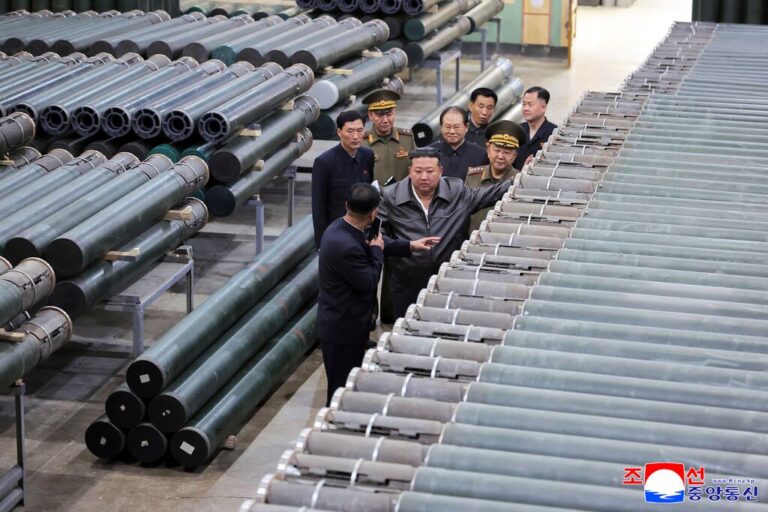SEOUL — Attack drones directed by artificial intelligence. Tanks with improved electronic warfare systems. A newly built naval destroyer fitted with supersonic cruise missiles. A new air defense system. Air-to-air missiles.
The list of new weapons being touted by North Korea grows almost by the week.
Long-held conventional wisdom had it that North Korea — crippled by international sanctions, natural disasters, and the coronavirus pandemic — was unable to upgrade its decrepit Soviet-era military because it lacked the money, fuel, spare parts, and technology required. But its leader, Kim Jong Un, found a solution to his country’s decades-old problem. He courted Russia after it invaded Ukraine three years ago and ran into a dire shortage of both troops and conventional weapons, including artillery shells. North Korea had plenty of both to provide.
In return, Moscow has revived a Cold War-era treaty of mutual defense and cooperation with Pyongyang, supplying North Korea not only with fuel and food, but also with materials and technologies to modernize its military, according to South Korean officials and analysts. They warn that the growing expansion of military cooperation between Russia and North Korea, if left unchecked, could threaten a delicate military balance around the Korean Peninsula.
The disintegration of the old Soviet bloc, and the subsequent collapse of North Korea’s economy, created a yawning gap between North and South Korea in their conventional weapons abilities. To counter that, North Korea in recent decades dedicated its limited resources to developing nuclear warheads and their delivery missiles. Still, the North’s conventional weaponry remained many years behind that of South Korea and the United States, which keeps 28,500 troops in the South.
Russia’s war against Ukraine has brought Kim a military bonanza.
It gave North Korea opportunities to test its weapons and troops and to gain valuable insights into modern warfare. Its conventional weapons industry has entered a renaissance, thanks to Russia’s insatiable demand for its artillery shells and missiles and the military technology flowing the other way, South Korean analysts said.
Kim now has greater ability to destabilize the East Asia region and more leverage should he sit down again with President Donald Trump or China’s leader, Xi Jinping, they said.
“North Korea appears to be entering a strategic golden age,” said Yang Uk, an expert on the North Korean military at the Asan Institute for Policy Studies in Seoul.
The alliance has benefited President Vladimir Putin of Russia, too. For months, Russian officials concealed the fact that North Korean troops were taking part in efforts to push Ukrainians out of the Kursk region, in western Russia. It was only at the end of April, when most of the Ukrainian-occupied area had been liberated, that the head of the Russian General Staff said during a public meeting with Putin that North Korean troops “provided significant assistance” to the Russian army there.
Perhaps more valuably, North Korea sent millions of artillery rounds, as well as many missiles, to Russia. South Korean officials said that North Korea was also cooperating with Russia to build drones for both nations. Russia’s resurgence in the war has given Putin a stronger hand in any potential peace negotiations with Ukraine, and with Trump.
The courtship between Kim and Putin deepened when they met in Russia’s Far East in September 2023. Kim was shown around a Russian space-launch station, an aircraft manufacturing factory, and air force and naval bases, compiling what South Korean analysts called a “bucket list” of Russian technologies he wanted to get his hands on.
Last June, Kim invited Putin to Pyongyang, the North’s capital, to sign an alliance treaty. Soon, North Korean troops began streaming into Russia, numbering up to 15,000 in all, according to South Korean intelligence officials
North Korean troops took part in recapturing two villages in the Kursk region, said Dmitri Kuznets, an analyst with the news outlet Meduza, which was outlawed by the Kremlin and operates from Latvia. But the true extent of the troops’ contributions has been debated.
Valery Shiryaev, an independent Russian military analyst, said in a post on Telegram, a popular messaging app, that the participation of Koreans in real battles was Kim’s idea, so that he could test his army.
“All of them are getting an incredible experience now and will come back as real veterans,” Shiryaev said. “There are no such people in the South Korean army, which undoubtedly fills Kim Jong Un with pride.”
Analysts in South Korea and other Western powers have been tallying Kim’s hardware gains. They have monitored aircraft and ships carrying what appeared to be Russian military technologies to North Korea.
Kim’s prioritizing of drones alone would help significantly narrow the gap with South Korea in conventional weapons, analysts said.
In April, Kim and his daughter, Kim Ju Ae, widely believed to be his heir, attended the launching of the North’s first naval destroyer, the Choe Hyon. He later watched the ship test-fire various missiles. One of them was called a supersonic cruise missile by North Korea, and it resembled the nuclear-capable Russian cruise missile 3M22 Zircon, said Hong Min, a military expert at the Korea Institute for National Unification in Seoul.
While launching the destroyer, Kim Jong Un reconfirmed that he was also building a nuclear-powered submarine.
Multiple UN Security Council resolutions ban arms trading with North Korea. But military cooperation with Russia “has proved a perfect route for the North to evade sanctions and overcome its technological limits,” said a report from the Institute for National Security Strategy in Seoul.
There remains doubt over how much sensitive technology Russia is willing to share with North Korea. North Korea has repeatedly failed to launch military spy satellites. And to build a nuclear-powered submarine, the country would need a small nuclear reactor.
Such a submarine, which would vastly improve its ability to cross the Pacific and launch a nuclear attack on the US mainland, was so politically risky that Moscow would be “very, very cautious,” said Doo Jin-ho, a senior analyst at the Korea Institute for Defense Analyses in Seoul.
But the mere threat it could happen gives Kim more leverage, and North Korean state media has shown part of what it said was a nuclear-powered submarine under construction.
“It’s the most dangerous weapon North Korea has unveiled so far,” said Hong, of the Korea Institute for National Unification.
This article originally appeared in The New York Times.



